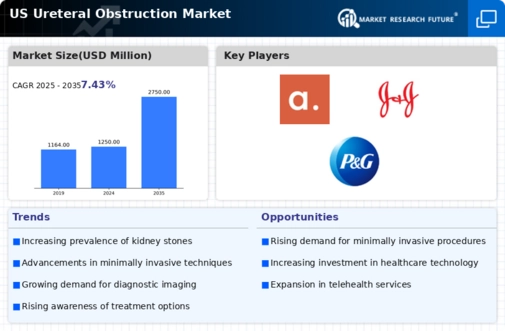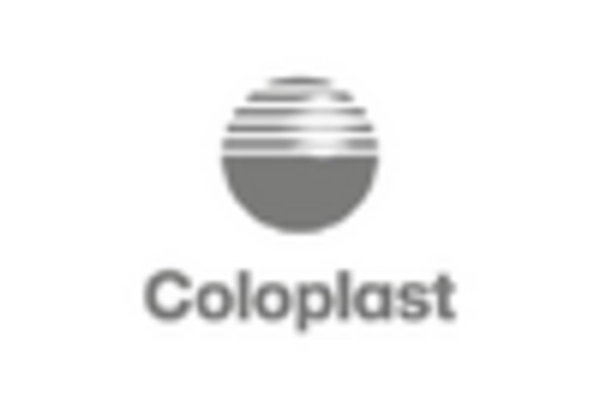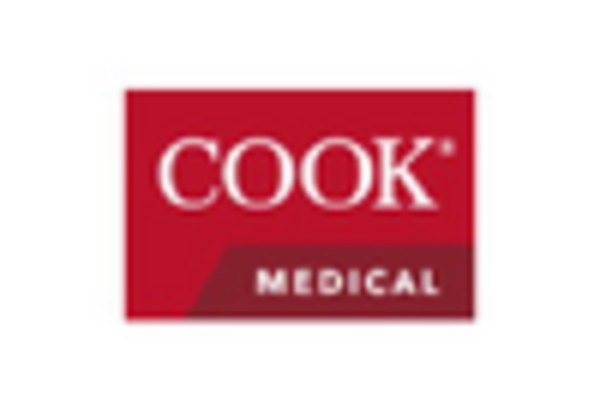Increasing Prevalence of Kidney Stones
The rising incidence of kidney stones in the US is a primary driver for the ureteral obstruction market. Studies indicate that approximately 10% of the population will experience a kidney stone at some point in their lives. This condition often leads to ureteral obstruction, necessitating medical intervention. The ureteral obstruction market is likely to benefit from this trend, as healthcare providers seek effective solutions to manage and treat these obstructions. Furthermore, the economic burden associated with kidney stones, estimated at over $5 billion annually in the US, underscores the need for innovative treatment options. As awareness of kidney stone prevention and management grows, the demand for ureteral obstruction treatments is expected to increase, further propelling market growth.
Advancements in Minimally Invasive Procedures
The ureteral obstruction market is experiencing a shift towards minimally invasive surgical techniques. These advancements, including ureteroscopy and laser lithotripsy, offer patients reduced recovery times and lower complication rates compared to traditional surgical methods. The adoption of these technologies is likely to enhance patient outcomes and satisfaction, driving demand for ureteral obstruction treatments. According to recent data, minimally invasive procedures have shown a success rate of over 90% in treating ureteral obstructions, which may encourage more healthcare facilities to invest in these technologies. As the healthcare landscape continues to evolve, the emphasis on patient-centered care and efficient treatment options will likely sustain the growth of the ureteral obstruction market.
Aging Population and Associated Health Issues
The demographic shift towards an aging population in the US is a significant factor influencing the ureteral obstruction market. As individuals age, the likelihood of developing urinary tract disorders, including ureteral obstructions, increases. The US Census Bureau projects that by 2030, nearly 20% of the population will be 65 years or older. This demographic trend suggests a growing need for effective management of ureteral obstructions, thereby expanding the market. Additionally, older adults often have comorbidities that complicate urinary health, further driving the demand for specialized treatments. The ureteral obstruction market must adapt to these changing demographics to meet the needs of this population segment.
Technological Integration in Healthcare Systems
The integration of advanced technologies within healthcare systems is poised to impact the ureteral obstruction market positively. Innovations such as telemedicine, electronic health records, and artificial intelligence are streamlining patient care and improving treatment outcomes. These technologies facilitate better diagnosis and management of ureteral obstructions, potentially leading to increased patient engagement and adherence to treatment plans. The ureteral obstruction market may see a rise in demand as healthcare providers leverage these technologies to enhance service delivery. Moreover, the potential for data analytics to identify trends in patient outcomes could inform future treatment protocols, further driving market growth.
Rising Awareness and Education on Urological Health
Increased awareness and education regarding urological health are contributing to the growth of the ureteral obstruction market. Public health campaigns and educational initiatives have highlighted the importance of early detection and treatment of urinary disorders. This heightened awareness is likely to lead to more individuals seeking medical advice for symptoms related to ureteral obstruction. As patients become more informed about their health, they may be more inclined to pursue treatment options, thereby driving market demand. Furthermore, healthcare providers are increasingly focusing on patient education as part of their practice, which may further enhance the visibility of ureteral obstruction treatments within the healthcare system.

















Leave a Comment